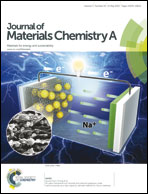Plasmonic, interior-decorated, one-dimensional hierarchical nanotubes for high-efficiency, solid-state, dye-sensitized solar cells†
Abstract
We report a high energy conversion efficiency of 8.4% at 100 mW cm−2, which is one of the highest values for N719-based, solid-state, dye-sensitized solar cells (ssDSSCs). Our solar cells are based on one-dimensional (1D) hierarchical hetero-nanotubes consisting of Au cores and SnO2/TiO2 nanosheet double shells (referred to as Au@SnO2@TNSs). Carbonaceous nanofibers (CNFs) with tellurium (Te) cores are used as dual templates for the inner-deposition of gold and the outer-deposition of the metal oxide layers. An organized mesoporous TiO2 (OM-T) film, with high porosity, large pores, and good interconnectivity, is also prepared via a graft copolymer template approach and utilized as a matrix to disperse the 1D hierarchical nanostructures. Such nanostructures provide good pore-filling for solid electrolytes, faster electron transfer, and enhanced light scattering, as confirmed by reflectance spectroscopy, incident photon-to-electron conversion efficiency (IPCE) spectroscopy, and intensity-modulated photocurrent spectroscopy (IMPS)/intensity-modulated photovoltage spectroscopy (IMVS).


 Please wait while we load your content...
Please wait while we load your content...